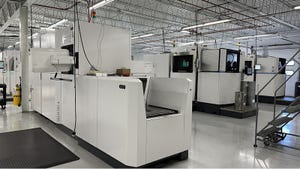July 19, 2010

Anall-in-one machine and motion controller is helping a machine builder set newlevels of performance and economy in the stone cutting sector.
The new Quantum bridge saw from Farnese Australia provides X, Y androtational motion for the fast and efficient shaping of stone kitchen andbathroom surfaces, and sets a new price/performance standard compared to existingmachines in this market sector.
Simplifying Complex Motions_B |
"The biggest challenge with applicationdevelopment was to simplify the operation of the machine," says Jason DeSouza, applicationsmanager for BaldorAustralia. "Farnese specified that the operator interface should not requireany G-Code, or CAD/CAM software or special computer hardware."
Baldor controllers used in the applicationare programmed in a proprietary language called MINT that incorporates complexinterpolated motion into a simple command set. This gives the programmerflexibility to generate motion profiles quickly and easily without the need foradditional software.
"Machine cutting paths are based ona range of pre-defined geometric shapes and dimensional information entered bythe user," says DeSouza. "These are used to calculate and pre-load motioncommands which are executed in real time within the controller. Therefore, themachine does not experience any time delays associated with standard computeroperating systems."
A unique user interface developed by Farnese makes selection of the rightshape-cutting process very easy, avoiding much of the risk of operator error. Arange of pre-programmed shape-cutting sequences are provided to cover commonrequirements, eliminating the need for skilled operator programming by thekitchen and bathroom surface suppliers that typically purchase these machines.The sequences include ready-to-use templates for the major sink manufacturers,for example. The interface also supports more complex applications, allowingprogramming using G-code as well as manual control.
Simplifying Complex Motions_A |
The programming environment offers high-levelkeywords for the complex movements that Farnese requires, such as angular andcircular cuts. Workbench also provides tools that allow Farnese to provide remotesupport for its machines, allowing diagnostics to be run and utilities for drivetuning.
Farnese Australia has been manufacturingstone-cutting and polishing machines for 10 years. With its latest product, theQuantum bridge saw, the company switched to an Ethernet-based NextMove e100 controllerfrom Baldor. This provides all of the resources required for the real-timeinterpolated control of four servomotor axes, all of the I/O on the machine,plus an ActiveX interface to the unique Windows user interface that Farnese hasdeveloped over many years to simplify stonemasonry.
Quantum provides a large cutting area of 3.7x 2m. Four servomotors control the motion of the rotary saw tool, which movesover the worktable on a gantry. Two synchronized axes drive the gantry alongthe worktable because of the weight and rigidity of the tool that is requiredfor precision sawing over a large operating area. The other two axes providetransverse movement along the gantry, and rotational motion of the tool head.The latter axis eliminates the need to reposition the workpiece or tool forchanges of cutting direction, and can make angular and circular cuts to radiias small as 10 mm. The four axes employ single-phase Baldor MicroFlex e100drives driving BSM servomotors. These axes, plus all of the sensors andactuators required on the machine, are controlled by the motion and machinecontroller.
"Themost significant technical aspect of the machine is the minimal hardwarerequired," says DeSouza. "This is mainly attributed to the Ethernet Powerlinknetwork used by the NextMove E100 controller and Microflex E100 servo drives."
The four servo axes on the machineare coordinated in real time through a single Ethernet cable. This reducescontrol wiring significantly while maintaining a very high level of performanceand accuracy. Each servo drive is equipped with local digital I/O for end-of-traveland orient switches. This frees up the main controller to interface withgeneral-purpose I/O required for the machine without hardware expansionmodules.
About the Author(s)
You May Also Like







